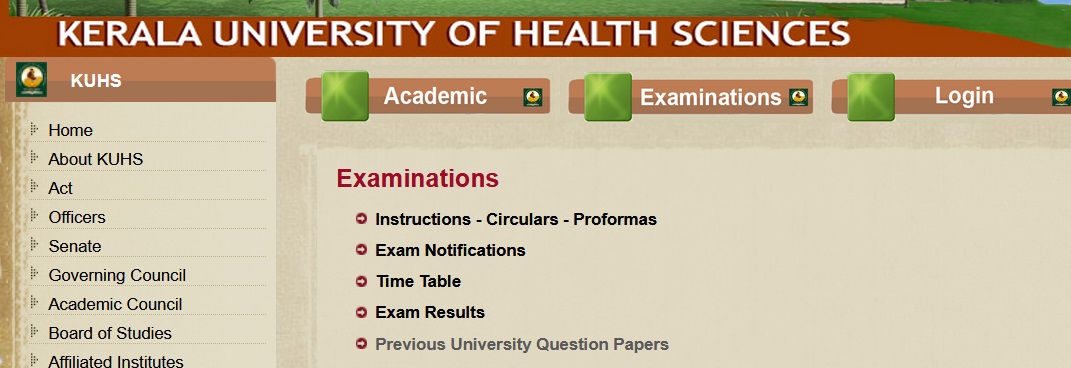Systematic And Diagnostic Bacteriology M.Sc MLT Question Paper : kuhs.ac.in
Name of the University : Kerala University of Health Sciences
Degree : M.Sc. MLT
Subject Name : Systematic And Diagnostic Bacteriology
Year : I
Document Type : Model Question Paper
Website : kuhs.ac.in
Download Model/Sample Question Paper :
Paper-I : https://www.pdfquestion.in/uploads/kuhs.ac.in/3612-3-PAPER%20-%20I.pdf
Paper-II : https://www.pdfquestion.in/uploads/kuhs.ac.in/3612-2-PAPER-%20II.pdf
Paper-III : https://www.pdfquestion.in/uploads/kuhs.ac.in/3612-4-PAPER-%20III.pdf
Paper-IV : https://www.pdfquestion.in/uploads/kuhs.ac.in/3612-2-PAPER-%20IV.pdf
KUHS Systematic & Diagnostic Bacteriology Question Paper
First Year M.Sc. MLT Degree Examinations –
(Microbiology)
PAPER – II : SYSTEMATIC AND DIAGNOSTIC BACTERIOLOGY
Time: 3 hrs.
Max. marks : 100
Answer all questions :
Draw diagrams wherever necessary:
Related : Kerala University of Health Sciences Physical Rehabilitation MPT Question Paper : www.pdfquestion.in/3607.html
Essays: (10×10 = 100)
1. ETEC
2. Non-gonococcal urithritis
3. Zoonotic infections
4. Rapid methods of blood culture
5. Toxigenicity tests in corynebacterium diphtheriae
6. Laboratory diagnosis of meningococcal meningitis
7. Pigment producing bacteria
8. Pathogenesis and laboratory diagnosis of gas gangrene
9. Primary atypical pneumonia
10. Rapid methods of ABST

Immunology
(Microbiology)
PAPER- IV :
Time: 3 hrs.
Max. marks : 100
Answer all questions :
Draw diagrams wherever necessary :
Essays: (10×10 = 100)
1. Define and classify immunity. Describe acquired immunity in detail.
2. Describe type-4 hypersensitivity reactions in detail with suitable examples.
3. lmmunofluorescence- principle, types and applications.
4. Describe in brief the immunology of malignancy.
5. Principle of production of monoclonal antibody and its applications.
6. Classify antigen-antibody reactions. Describe agglutination reactions in detail.
7. Define complements and name the components. Describe classical complement pathway in detail.
8. Principle, types and applications of immunoblot methods.
9. Define and classify immunodeficiency diseases with suitable examples .
10. Define antigen. Types of antigens and determinants of antigenicity.
General Microbiology
February 2013 :
(Microbiology)
PAPER – I :
Time: 3 hrs.
Max. marks: 100
Answer all questions :
Draw diagrams wherever necessary:
Essays: (10×10 = 100)
1. Functioning and monitoring of bio safety cabinet .
2. Biomedical waste management in the microbiology laboratory.
3. Functioning and monitoring of autoclave.
4. Testing of disinfectants.
5. Bacterial spore and its significances.
6. Methods of bacterial preservation.
7. Gene transfer in bacteria.
8. Automated identification systems.
9. Principle and uses fluorescent microscopy.
10.Bacterial growth curve and significance of the different phases
Medical Parasitology & Mycology
February 2013 :
(Microbiology)
PAPER – Ill :
Time: 3 hrs.
Max.marks : 100
Answer all questions :
Draw diagrams wherever necessary :
Essays: (10×10 = 100)
1. Immune response to parasitic infections
2. Life cycle of balantidium coli.
3. Cultivation of leishmania donovani.
4. Life cycle of taenia saginata.
5. Laboratory diagnosis of dracunculosis.
6. Rhinosporidiosis.
7. Keratomycosis.
8. Blastomyces dermatitidis.
9. Pneumocystis carinii.
10. Stains used in mycology.
Enzymology & Inborn Errors Of Metabolism
Time: 3 hrs.
Max.marks : 100
Answer all questions
Draw diagrams wherever necessary
Essays: (10×10 = 100)
1. What is IUBMB .Classify enzymes according to the IUBMB classification with examples. Mention two differences between competitive and noncompetitive inhibition of enzymes. (2+ 6+2)
2. Discuss Embden -Meyerhof pathway ( aerobic and anaerobic) for Glycolysis. Add a note on its energetics. ( 8+2)
3. Explain in detail the metabolism of tyrosine . Add a note on any two important substances derived from Tyrosine. (8+2)
4. Short notes • differential diagnosis of jaundice and its importance. • Synthesis of creatine phosphate (5+ 5)
5. Short notes: • Acetyl Co A • Ketogenesis and utilization of Ketone bodies.
6. Discuss briefly: • Regulation of cholesterol synthesis • lipoprotein structure (5+5) (5+5)
7. What is an inborn error of metabolism. Mention the enzyme defect, lab test and clinical signs to detect Von Gierke’s disease, Niemann -Picks disease and Cutanea porphyria tarda. (1+3+3+3)
8. Schematically name and represent the components of electron transport chain. Add a note on mechanism of ox idative phosphorylation by chemiosmotic theory. ( 6+4)
9. What is a genetic mutation. Explain point and frame shift mutations . What is Down’s syndrome and name any three tests for the screening of down’s syndrome. (2+4+4)
10.Role of lipids in atherosclerosis and coronary heart disease .Add a note on serum lipid profile and their reference ranges. (6+4)